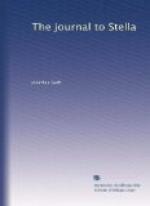2 Swift was afterwards President of this Club, which is better known as “the Society.”
3 Perhaps Daniel Reading, M.P. for Newcastle, Co. Dublin.
4 Afterwards Congreve formed a friendship with the
Whigs; or, as Swift put it,
“Took proper principles
to thrive,
And so might every
dunce alive.”
5 Atterbury.
6 This pamphlet, published in February 1712, was called “A Proposal for Correcting, Improving, and Ascertaining the English Tongue, in a Letter to the. . . Lord High Treasurer.”
7 No. 47
8 Francis Gastrell, Canon of Christ Church, was made Bishop of Chester in 1713. His valuable Notitia Cestriensis was published in 1845-50.
9 Near Fulham.
10 See Letter 12, note 21.
11 The daughters of Meinhardt Schomberg, Duke of Leinster, in Ireland, and third Duke of Schomberg. Lady Mary married Count Dagenfeldt, and Lady Frederica married, first, the Earl of Holderness, and, secondly, Earl Fitz Walter.
12 Thomas Harley.
13 See Letter 19, note 3.
Letter 26.
1 The widow of Sir John Lyndon, who was appointed a justice of the Court of King’s Bench in Ireland in 1682, and died in 1699.
2 “Marmaduke Coghill, ll.D., was judge of the Prerogative Court in Ireland. About this time he courted a lady, and was soon to have been married to her; but unfortunately a cause was brought to trial before him, wherein a man was sued for beating his wife. When the matter was agitated, the Doctor gave his opinion, ’That although a man had no right to beat his wife unmercifully, yet that, with such a little cane or switch as he then held in his hand, a husband was at liberty, and was invested with a power, to give his wife moderate correction’; which opinion determined the lady against having the Doctor. He died an old man and a bachelor” (Deane Swift). See also Lascelles, Liber Muner. Hibern., part ii. p. 80.
3 This was a common exclamation of the time, but the spelling varies in different writers. It seems to be a corruption of “God so,” or “God ho,” but there may have been a confusion with “cat-so,” derived from the Italian “cazzo.”
4 See Letter 9, note 28. Mrs. Manley was now editing the Examiner.
5 Sir Henry Belasyse was sent to Spain as Commissioner to inquire into the state of the English forces in that country. The son of Sir Richard Belasyse, Knight of Ludworth, Durham, Sir Henry finished a chequered career in 1717, when he was buried in Westminster Abbey (Dalton’s Army Lists, ii. 228). In his earlier years he served under the United Provinces, and after the accession of William was made a Brigadier-General in the English army, and in 1694, Lieutenant-General. In 1702 he was second in command of the expedition to Cadiz, but he was dismissed the service in consequence of the looting of Port St. Mary. Subsequently he was elected M.P. for Durham, and in 1713 was appointed Governor of Berwick.




